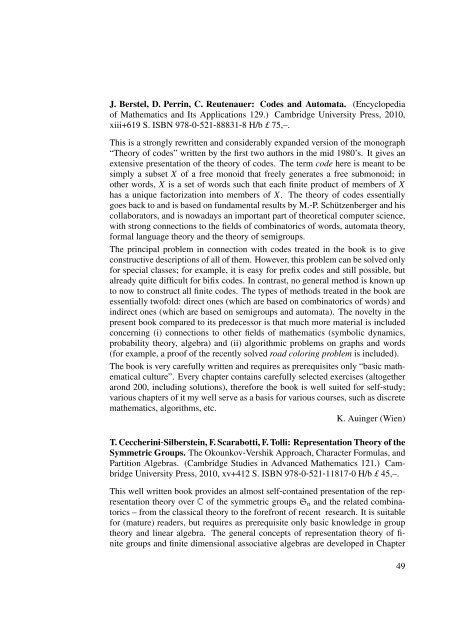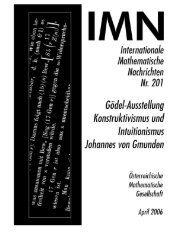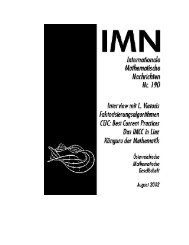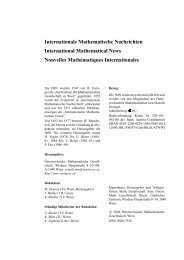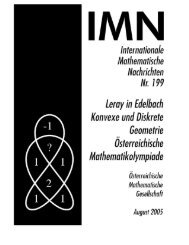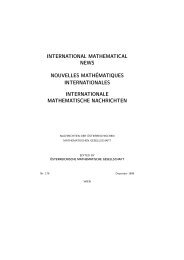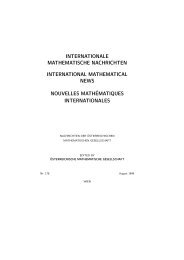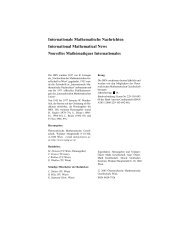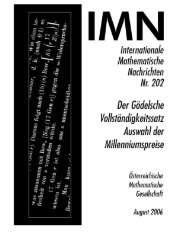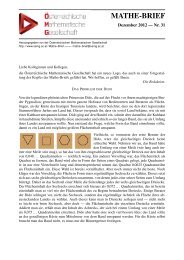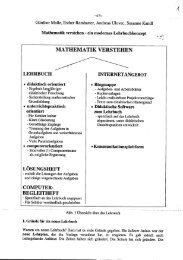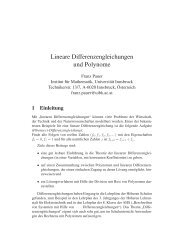218 - Ãsterreichische Mathematische Gesellschaft
218 - Ãsterreichische Mathematische Gesellschaft
218 - Ãsterreichische Mathematische Gesellschaft
Sie wollen auch ein ePaper? Erhöhen Sie die Reichweite Ihrer Titel.
YUMPU macht aus Druck-PDFs automatisch weboptimierte ePaper, die Google liebt.
J. Berstel, D. Perrin, C. Reutenauer: Codes and Automata. (Encyclopedia<br />
of Mathematics and Its Applications 129.) Cambridge University Press, 2010,<br />
xiii+619 S. ISBN 978-0-521-88831-8 H/b £ 75,–.<br />
This is a strongly rewritten and considerably expanded version of the monograph<br />
“Theory of codes” written by the first two authors in the mid 1980’s. It gives an<br />
extensive presentation of the theory of codes. The term code here is meant to be<br />
simply a subset X of a free monoid that freely generates a free submonoid; in<br />
other words, X is a set of words such that each finite product of members of X<br />
has a unique factorization into members of X. The theory of codes essentially<br />
goes back to and is based on fundamental results by M.-P. Schützenberger and his<br />
collaborators, and is nowadays an important part of theoretical computer science,<br />
with strong connections to the fields of combinatorics of words, automata theory,<br />
formal language theory and the theory of semigroups.<br />
The principal problem in connection with codes treated in the book is to give<br />
constructive descriptions of all of them. However, this problem can be solved only<br />
for special classes; for example, it is easy for prefix codes and still possible, but<br />
already quite difficult for bifix codes. In contrast, no general method is known up<br />
to now to construct all finite codes. The types of methods treated in the book are<br />
essentially twofold: direct ones (which are based on combinatorics of words) and<br />
indirect ones (which are based on semigroups and automata). The novelty in the<br />
present book compared to its predecessor is that much more material is included<br />
concerning (i) connections to other fields of mathematics (symbolic dynamics,<br />
probability theory, algebra) and (ii) algorithmic problems on graphs and words<br />
(for example, a proof of the recently solved road coloring problem is included).<br />
The book is very carefully written and requires as prerequisites only “basic mathematical<br />
culture”. Every chapter contains carefully selected exercises (altogether<br />
arond 200, including solutions), therefore the book is well suited for self-study;<br />
various chapters of it my well serve as a basis for various courses, such as discrete<br />
mathematics, algorithms, etc.<br />
K. Auinger (Wien)<br />
T. Ceccherini-Silberstein, F. Scarabotti, F. Tolli: Representation Theory of the<br />
Symmetric Groups. The Okounkov-Vershik Approach, Character Formulas, and<br />
Partition Algebras. (Cambridge Studies in Advanced Mathematics 121.) Cambridge<br />
University Press, 2010, xv+412 S. ISBN 978-0-521-11817-0 H/b £ 45,–.<br />
This well written book provides an almost self-contained presentation of the representation<br />
theory over C of the symmetric groups S n and the related combinatorics<br />
– from the classical theory to the forefront of recent research. It is suitable<br />
for (mature) readers, but requires as prerequisite only basic knowledge in group<br />
theory and linear algebra. The general concepts of representation theory of finite<br />
groups and finite dimensional associative algebras are developed in Chapter<br />
49


